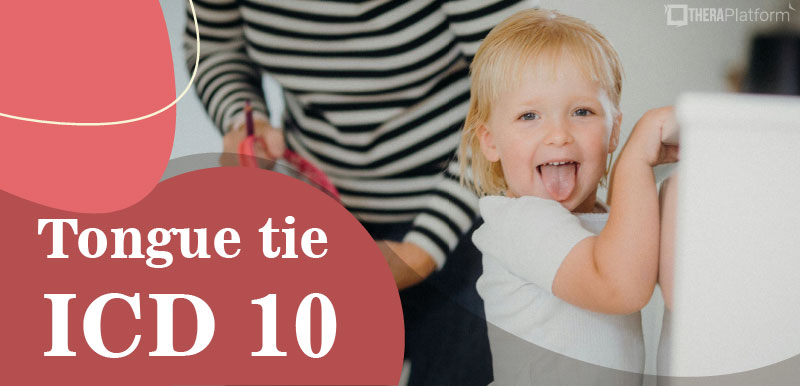Stuttering ICD 10

Stuttering ICD 10 code is used for a speech disorder that can have significant psychological, social, emotional, and functional consequences for the individual. Stuttering is the most common fluency disorder, and refers to an interruption in the flow of speaking.
→ Click here to enroll in our free on-demand Insurance Billing for Therapists video course [Enroll Now]
Speech therapy plays a critical role in the assessment and intervention of stuttering. Accurate diagnosis and coding of stuttering are critical for effective treatment planning, progress monitoring, and ensuring appropriate reimbursement for services.
The International Classification of Diseases, 10th Edition (ICD-10) is the globally recognized medical coding system created by the World Health Organization (WHO). ICD-10 codes correspond to specific medical diagnoses, and using the accurate code in documentation can help ensure reimbursement through payers occurs and that appropriate interventions are provided.
Follow along as we explore the ICD-10 code used for stuttering. We’ll also give a comprehensive look at the diagnosis, including evidence-based procedures for assessment and intervention, and other considerations to make when working with clients who stutter.

What is the Stuttering ICD 10 code?
Stuttering is defined by ASHA as “an interruption in the flow of speaking characterized by specific types of disfluencies.” These include repetitions, prolongations, and blocks in speech sounds and words. Individuals who stutter may also show signs of physical tension (concomitant behaviors) during speaking tasks.
Several stuttering ICD 10 codes are used for this diagnosis, including F80.81 Childhood onset fluency disorder and F98.5 Adult onset fluency disorder.
There are 2 types of stuttering; developmental and acquired.
The exact cause of stuttering is often unknown.
However, there are several possible contributing factors, including:
- Neurophysiological differences
- Gender (stuttering is more commonly occurring with boys)
- Age of stuttering onset (later onset is associated with continued stuttering)
- Fami ly patterns of recovery from stuttering
Acquired stuttering is a type of stuttering that is caused by acquired brain damage. This includes stroke, neurodegenerative diseases, and trauma. The highest incidence of acquired stuttering is in adults.
Stuttering can significantly impact an individual’s speech fluency and communication abilities. The difficulties experienced by those who stutter can have social and emotional implications, causing many individuals to feel frustrated and isolated. This can lead to overall reduced quality of life.
Timely intervention and support can improve an individual’s outcomes towards improving their communication skills.
Watch this video to learn common insurance billing struggles and solutions
→ Start My Free Trial
→ Start My Free Trial
Stuttering ICD 10 codes
In healthcare, it is critical for providers to ensure they are using the correct ICD-10 code in their documentation. ICD-10 (International Classification of Diseases, 10th edition) is the official coding system for medical diagnoses created by the CDC. Using the most accurate ICD-10 code helps ensure consistency among different health professionals, the use of appropriate interventions, and reduce denials from payers.
Stuttering ICD 10 codes table
Code | Description |
|---|---|
F80.81 | Childhood onset fluency disorder |
F98.5 | Adult onset fluency disorder |
R47.82 | Fluency disorder in conditions classified elsewhere |
I69.323 | Fluency disorder (stuttering) following cerebral infarction |
I69.923 | Fluency disorder (Stuttering) following unspecified cerebrovascular disease |
When coding stuttering in conditions classified elsewhere, coding guidelines state that the underlying condition or disease (ex: Parkinson’s disease) should be coded first. This does not apply to an adult onset fluency disorder, in which F98.5 would be used.
The stuttering ICD 10 code F80.81 should also be used for another fluency disorder known as Cluttering.
→ Download My Free Insurance Billing Guide
Clinical assessment and diagnosis
A comprehensive clinical assessment of stuttering includes an examination of the severity and characteristics of the stuttering.
A speech-language pathologist’s assessment may consist of:
- Case history
- Client and/or caregiver interview about stuttering (ex: feelings towards stuttering, difficult speaking environments)
- Standardized fluency assessment
- Speech and language assessment
- Oral motor examination
When analyzing the results of speech samples within standardized fluency assessments and informal clinical measures, the SLP will look at several aspects of stuttering, including:
- Types of dysfluencies (repetitions, prolongations, and blocks)
- Percentage of syllables stuttered
- Physical reactions to stuttering (concomitant behaviors)
- Emotional/behavioral reactions to stuttering
Information such as the length of time the individual has stuttering, the time of onset, and any family history of stuttering can also provide the SLP with valuable information about the severity of stuttering and prognosis for improvement.
Accurate documentation is essential for stuttering ICD 10 coding. This includes description of assessment results, diagnostic impressions, and individualized treatment goals. Maintaining thorough, up-to-date documentation can help SLPs ensure compliance with coding guidelines.
Treatment and intervention strategies
Evidence-based interventions through speech therapy for stuttering include fluency shaping techniques, stuttering modification strategies, and cognitive-behavioral therapy. These approaches can enhance an individual’s speech fluency, reduce associated anxiety, and improve overall communication skills.
Speech therapists can develop specific treatment goals for stuttering that are tailored to the client’s needs, preferences, and functional goals. For example, a strategy of easy onset might be taught to a client who stutters on the initial sound or syllable of a word when starting to speak.
Speech therapy should target fluency within a variety of functional speaking environments and with various communication partners. Family and caregiver involvement in treatment is important, and includes providing education on fluency and direct and indirect fluency enhancing strategies.
Therapists have the ability to monitor clients’ progress and adjust treatment plans as indicated based on the results of ongoing assessments and documentation of stuttering ICD 10 coded data. Periodic re-assessments using standardized and informal clinical measurements can provide valuable insight.
Impact on speech and language development
Some individuals who stutter have co-occurring speech and language disorders. Stuttering can affect an individual’s expressive language development in some cases because he or she may avoid speaking, which can limit their linguistic complexity.
According to ASHA, there is conflicting evidence when it comes to differences in language skills in those who do have a fluency disorder and those who do not. Children who stutter may have weaker receptive and expressive vocabularies, poorer lexical skills, and a reduced length of utterance compared to those who do not stutter. However, increased skills in these areas have also been found in some studies.
According to research, about 6.88% of children who stutter also have a speech sound disorder. Speech therapists utilize a variety of strategies to address communication difficulties in clients who stutter. The SLP may use language modeling, language stimulation strategies, and direct instruction for articulation to improve the client’s skills.
Ethical and cultural considerations
It is important for speech therapists to adhere to ethical principles when working with individuals who stutter and their families. This includes practicing confidentiality, respecting the client’s autonomy, and demonstrating cultural sensitivity. Fostering trust and developing a strong rapport is essential in addressing accompanying social-emotional effects of stuttering within therapy.
Professional development and resources
SLPs can continue to enhance their knowledge and skills in stuttering management through participation in continuing education courses, workshops, and professional conferences. Research publications, online resources, and clinical forums through national associations can also provide valuable updates and insight on best practices in intervention for stuttering.
Summary
Stuttering is the most common fluency disorder, and is defined as the disruption in the flow of speech. Stuttering can be characterized by repetitions, prolongations, and blocks. A comprehensive assessment that includes accurate use of stuttering ICD 10 coding can lead to effective, individualized intervention.
Speech therapists play an important role in comprehensive stuttering management. Targeting fluency difficulties that are specific to the client includes the use of specific fluency shaping techniques through functional therapeutic exercises.
Participating in ongoing research, advocacy, and collaboration are all part of providing quality care for individuals who stutter. Through this, SLPs can effectively improve the communication skills and overall quality of life for their clients.
Start 30-day Free Trial and explore TheraPlatform. HIPAA Compliant Video and Practice Management Software for Therapists.
How EHR and practice management software can save you time with insurance billing for therapists
EHRs with integrated billing software and clearing houses, such as TheraPlatform, offer therapists significant advantages in creating an efficient insurance billing process. The key is minimizing the amount of time dedicated to developing, sending, and tracking medical claims through features such as automation and batching.
What are automation and batching?
- Automation refers to setting up software to perform a series of tasks with limited human interaction.
- Batching or performing administrative tasks in blocks of time at once allows you to perform a task from a single entry point with less clicking.
Which billing and medical claim tasks can be automated and batched through billing software?
- Invoices: Create multiple invoices for multiple clients with a click or two of a button or set up auto-invoice creation and the software will automatically create invoices for you at the preferred time. You can even have the system automatically send invoices to your clients.
- Credit card processing: Charge multiple clients with a click of a button or set up auto credit card billing and the billing software will automatically charge the card (easier than swiping!)
- Email payment reminders: Never manually send another reminder email for payment again or skip this all together by enabling auto credit card charge.
- Automated claim creation and submission: Batch multiple claims with one click of a button or turn auto claim creation and submission on.
- Live claim validation: The system goes over each claim to catch any human errors before submitting, saving you time and reducing rejected claims.
- Automated payment posting: Streamline posting procedures for paid medical claims with ERA. When insurance offers ERA all the payments from them will be automatically posted on TheraPlatform’s EHR.
- Tracking: Track payment and profits including aging invoices, overdue invoices, transactions, billed services, service providers.
Utilizing billing software integrated with an EHR and practice management software can make the storage and sharing of billing and insurance an easy decision and can save providers time when it comes to insurance billing for therapists.
Resources
TheraPlatform is an all-in-one EHR, practice management, and teletherapy software built for therapists to help them save time on admin tasks. It offers a 30-day risk-free trial with no credit card required and supports different industries and sizes of practices, including speech-language pathologists in group and solo practices.

More resources
- Therapy resources and worksheets
- Therapy private practice courses
- Ultimate teletherapy ebook
- The Ultimate Insurance Billing Guide for Therapists
- The Ultimate Guide to Starting a Private Therapy Practice
- Insurance billing 101
- Practice management tools
Free video classes
- Free on-demand insurance billing for therapist course
- Free mini video lessons to enhance your private practice
- 9 Admin tasks to automate in your private practice
References
Junuzovic-Zunic, L., Sinanovic, O., & Majic, B. (2021). Neurogenic stuttering: etiology, symptomatology, and treatment. Medical Archives, 75(6), 456. DOI: ejmanager.com/mnstemps/10/10-1635965569.pdf?t=1716952599
Neef, N. E., & Chang, S. E. (2024). Knowns and unknowns about the neurobiology of stuttering. Plos Biology, 22(2), e3002492. DOI: https://doi.org/10.1371/journal.pbio.3002492
Unicomb, R., Kefalianos, E., Reilly, S., Cook, F., & Morgan, A. (2020). Prevalence and features of comorbid stuttering and speech sound disorder at age 4 years. Journal of communication disorders, 84, 105976. DOI: https://doi.org/10.1016/j.jcomdis.2020.105976



